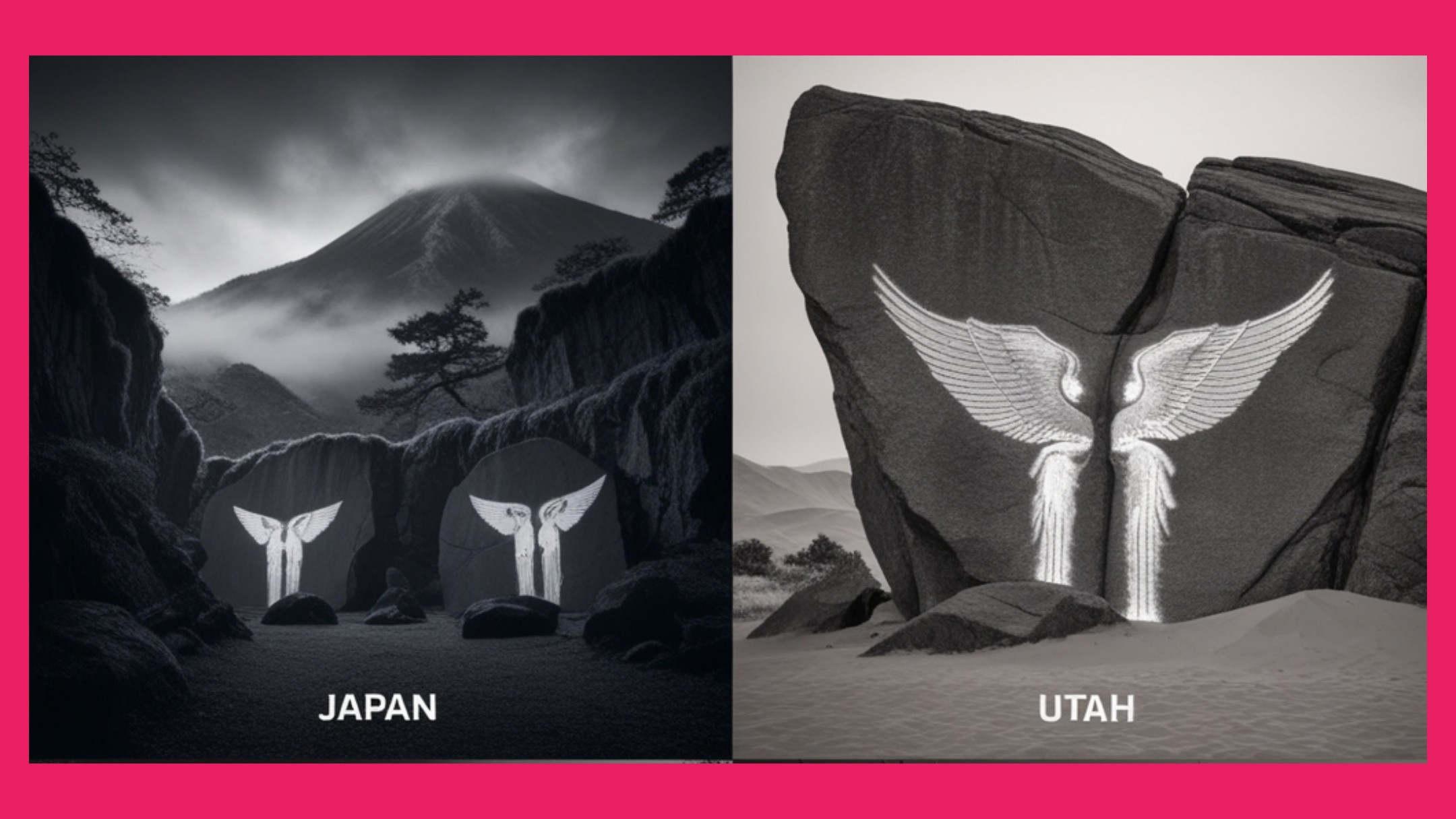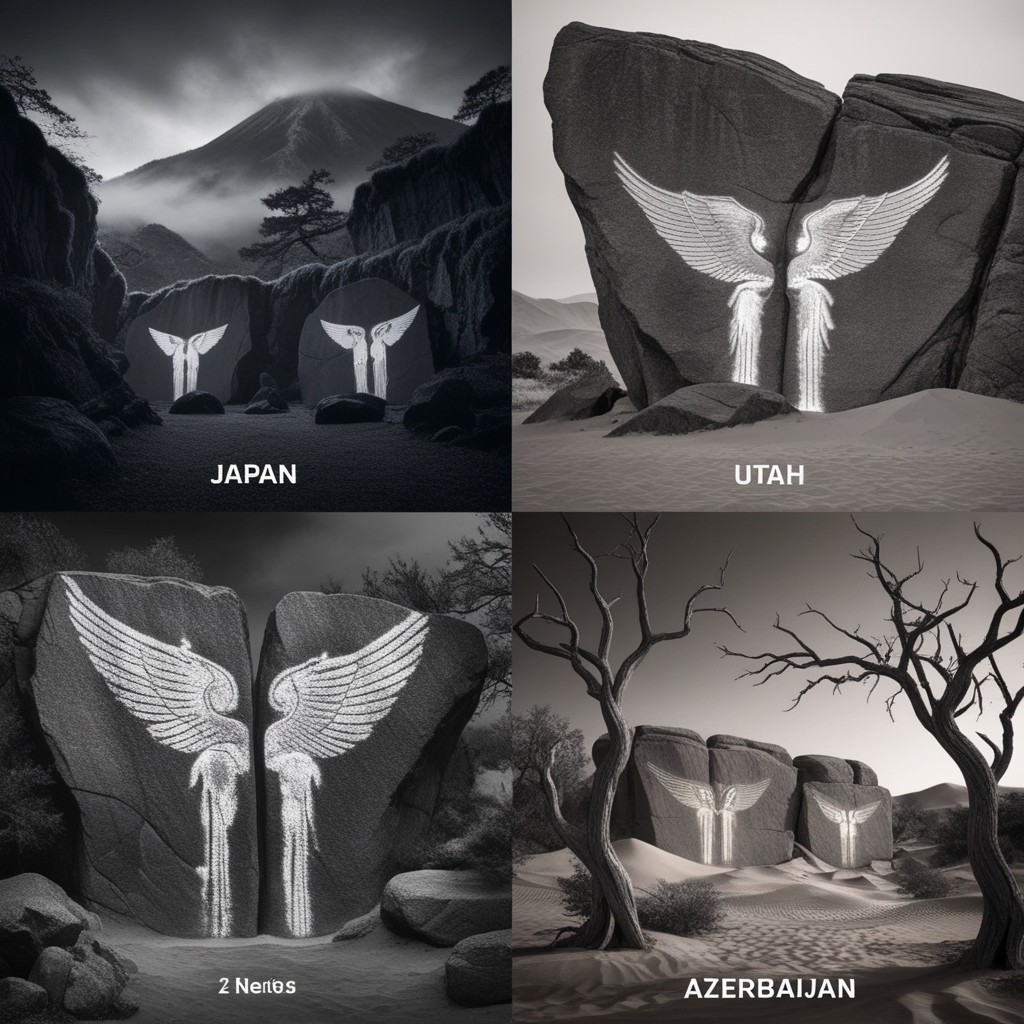
The Mystery of Ancient Winged Figures: A Shared Vision Across Civilization
 Human history is filled with enigmas that challenge our understanding of the past. Among these mysteries are ancient carvings—petroglyphs—found in Japan, Utah, and Azerbaijan. These carvings, etched thousands of years ago, depict nearly identical winged figures. How did such geographically distant cultures create such similar images? Could they have been connected, or do these carvings hint at something deeper in our shared human consciousness?
Human history is filled with enigmas that challenge our understanding of the past. Among these mysteries are ancient carvings—petroglyphs—found in Japan, Utah, and Azerbaijan. These carvings, etched thousands of years ago, depict nearly identical winged figures. How did such geographically distant cultures create such similar images? Could they have been connected, or do these carvings hint at something deeper in our shared human consciousness?
The Enigma of Winged Figures
The winged figures etched into stone are not mere decorations. They often appear in sacred or ceremonial contexts, suggesting a profound meaning. These symbols may represent divine beings, spiritual messengers, or even cosmic travelers. Yet, the most striking aspect is their uncanny resemblance across continents—Japan’s intricate stone art mirrors the carvings in Utah’s deserts and Azerbaijan’s rocky terrains.

Were Ancient Cultures Connected?
The similarities in these petroglyphs raise fascinating questions. Did these civilizations communicate through long-lost trade routes? Ancient travelers might have shared stories, myths, or artistic styles that transcended boundaries. Alternatively, some suggest that these figures represent a common vision or archetype—a collective myth embedded in humanity's psyche.
A Glimpse Into Shared Myths
Winged figures are often associated with flight, freedom, or divine intervention. From ancient Japanese folklore to Native American legends and the myths of the Caucasus, these symbols could reflect humanity’s desire to connect with higher realms. Despite their geographical distances, these civilizations might have envisioned similar celestial beings, showing how deeply connected we all are through shared stories and aspirations.
The Continuing Mystery
Historians and archaeologists remain puzzled by these petroglyphs. With no written records to explain their significance, the carvings leave much to speculation. Are they evidence of ancient global connections, or do they symbolize universal human experiences?
Why This Mystery Matters
Exploring mysteries like these enriches our understanding of humanity’s interconnected past. These carvings remind us that our ancestors, though separated by oceans and mountains, shared a common curiosity about the cosmos and the divine.
Final Thoughts
The ancient winged figures of Japan, Utah, and Azerbaijan are more than carvings; they are keys to understanding the shared visions of humanity. Whether you’re a history enthusiast or an archaeology lover, these symbols invite us to question, wonder, and dream about the stories that connect us all.
What do you think these winged figures represent? Share your thoughts below and join the journey to uncover the secrets of our ancient past!
The Mystery of Ancient Winged Figures: A Shared Vision Across Civilizations
Human history is filled with enigmas that challenge our understanding of the past. Among these mysteries are ancient carvings—petroglyphs—found in Japan, Utah, and Azerbaijan. These carvings, etched thousands of years ago, depict nearly identical winged figures. How did such geographically distant cultures create such similar images? Could they have been connected, or do these carvings hint at something deeper in our shared human consciousness?
The Enigma of Winged Figures
The winged figures etched into stone are not mere decorations. They often appear in sacred or ceremonial contexts, suggesting a profound meaning. These symbols may represent divine beings, spiritual messengers, or even cosmic travelers. Yet, the most striking aspect is their uncanny resemblance across continents—Japan’s intricate stone art mirrors the carvings in Utah’s deserts and Azerbaijan’s rocky terrains.
Were Ancient Cultures Connected?
The similarities in these petroglyphs raise fascinating questions. Did these civilizations communicate through long-lost trade routes? Ancient travelers might have shared stories, myths, or artistic styles that transcended boundaries. Alternatively, some suggest that these figures represent a common vision or archetype—a collective myth embedded in humanity's psyche.
A Glimpse Into Shared Myths
Winged figures are often associated with flight, freedom, or divine intervention. From ancient Japanese folklore to Native American legends and the myths of the Caucasus, these symbols could reflect humanity’s desire to connect with higher realms. Despite their geographical distances, these civilizations might have envisioned similar celestial beings, showing how deeply connected we all are through shared stories and aspirations.
The Continuing Mystery
Historians and archaeologists remain puzzled by these petroglyphs. With no written records to explain their significance, the carvings leave much to speculation. Are they evidence of ancient global connections, or do they symbolize universal human experiences?
Why This Mystery Matters
Exploring mysteries like these enriches our understanding of humanity’s interconnected past. These carvings remind us that our ancestors, though separated by oceans and mountains, shared a common curiosity about the cosmos and the divine.
---
Final Thoughts
The ancient winged figures of Japan, Utah, and Azerbaijan are more than carvings; they are keys to understanding the shared visions of humanity. Whether you’re a history enthusiast or an archaeology lover, these symbols invite us to question, wonder, and dream about the stories that connect us all.
What do you think these winged figures represent? Share your thoughts below and join the journey to uncover the secrets of our ancient past!
Copyright © 2025 Amazing Stories. All rights reserved.